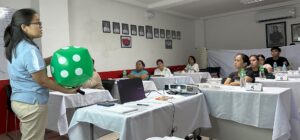Los Baños, Laguna. The International Rice Research Institute (IRRI) highlights the importance of safe, sustainable, and environment-friendly rice production as it joins the celebration of the World Environment Day (5 June) and Philippine Environment Month (June).
A mini campaign was launched featuring various IRRI farming technologies and practices that reduce the environmental footprint of rice farming and contribute to sustainability. This will continue throughout June, which is the Philippine Environment Month.
“Environmental sustainability has always been the goal of the institute,” says Dr. Grant Singleton, IRRI principal scientist. “It has been articulated decades ago in the Institute’s mission statement: ‘to reduce poverty and hunger, improve the health of rice farmers and consumers and ensure environmental sustainability of rice farming.’”
“One of the myths is that environment protection is a negative for economic development and food security,” says Dr. Singleton who is also coordinator of the project, Closing rice yield gaps in Asia with reduced environmental footprint (CORIGAP). “CORIGAP and a project called ‘Land-use intensity and ecological engineering-assessment tools for risks and opportunities in irrigated rice based production systems’ (LEGATO) are two examples of what IRRI is doing. We are looking at how we can promote environmental protection without compromising the increase in production, particularly in lowland intensive cropping systems.”
For example, through the ‘three controls technology’ developed under CORIGAP, rice farmers in China have reduced nitrogen fertilizer and pesticide use by 20% but increased their yields by 10%.
Another example is the ‘1 must do, 5 reductions,’ a package of technology, where ‘one must do’ is for farmers to use certified seeds, while the ‘five reductions’ means farmers must reduce the amount of seed, nitrogen application, pesticide use, water use, and postharvest losses.
“The ‘1 must do, 5 reductions’ technology aims to improve rice yield and quality, reduce the production cost, and increase the profit of farmers while reducing environmental pollution,” says Dr. Singleton. “As a result of this technology, 240,000 farmers from the Mekong Delta increased their yields by 10%. ”
IRRI’s research on the ecological engineering of rice ecosystems, supported by the Philippine Government’s Bureau of Agricultural Research and also included in the LEGATO project, looks for ways to diversify rice production systems while providing benefits for both nature and people.
“In initial experiments at IRRI, growing vegetables on rice bunds not only increased habitat diversity for beneficial animals and plants, but also provided additional income and better nutrition for farming households,” says Dr. Finbarr Horgan, an ecologist who focuses on reducing pesticide use in rice ecosystems and leader of the LEGATO project.
Carefully designed rice ecosystems that incorporate flowering plants and diverse food crops as “high-diversity vegetation patches” provide farmers with fruits and vegetables, enhance the aesthetics of rice production systems, and encourage beneficial birds, insects, and spiders into rice fields where they control the population of harmful pests, insects, and snails.
“Without the use of any pesticides, irrigated rice fields under ecological engineering yielded up to 9 tons per hectare,” says Dr. Horgan. “Ecologically engineered rice ecosystems indicate that balanced, healthy ecosystems can be productive and profitable.”
“With CORIGAP and LEGATO projects, we have continued our efforts in making rice production sustainable and environment-friendly,” Singleton says.
CORIGAP is funded by the Swiss Agency for Development and Cooperation, while LEGATO is funded by the German Ministry of Science and Education.
As part of IRRI’s celebration of the World Environment Day, the Institute invited Northern Arizona University (NAU) professor Catherine Propper to speak about amphibians as providers of ecosystem services to promote sustainable rice production.
According to Prof. Propper, frogs and toads are in the middle of the food chain, so they could serve as indicators of a functional, healthy rice ecosystem. Moreover, these amphibians could help reduce the use of pesticides because they feed on insects. Frogs and toads can also serve as sentinels for human health. Some agricultural chemicals can disrupt endocrine systems, and these systems are virtually the same in amphibians as they are in humans.
Studies to better understand the important role of frogs and toads in the sustainability of rice ecosystems are now being conducted by the Institute in collaboration with NAU and the National Museum of the Philippines.
“Now, a team led by IRRI scientist Sarah Beebout is working on developing indicators to quantify environmental sustainability in lowland rice wetlands to track how we are progressing,” says Dr. Singleton. “As of now, IRRI in partnership with the United Nations Environment Programme has developed eight indicators to assess the environmental health of rice fields.”
Quoting UN Secretary-General Ban Ki-moon, Dr. Singleton says, “Lifting people from poverty and protecting the planet’s resources are two sides of the same coin. Both must be at the heart of any framework.”
Learn more about IRRI (www.irri.org) or follow us on the social media and networks (all links down the right column).










